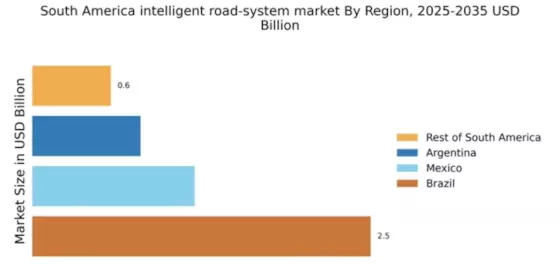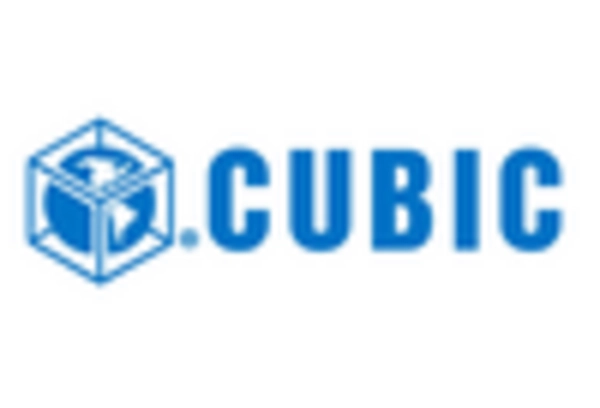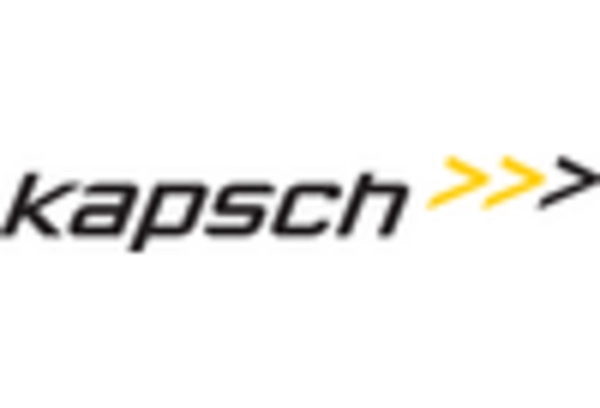Increased Focus on Road Safety
The increasing focus on road safety is a significant driver for the intelligent road-system market in South America. With rising traffic accidents and fatalities, there is a pressing need for solutions that enhance safety on the roads. Intelligent road systems, equipped with advanced monitoring and alert systems, can play a crucial role in mitigating risks. For example, the integration of real-time data analytics can help identify hazardous conditions and provide timely warnings to drivers. Additionally, initiatives aimed at improving pedestrian safety through smart crosswalks and vehicle-to-infrastructure communication are gaining traction. As governments prioritize road safety, investments in intelligent road systems are likely to increase, potentially leading to a market expansion of around 15% in the coming years.
Government Initiatives for Smart Mobility
Government initiatives in South America are increasingly focusing on enhancing mobility through intelligent road systems. These initiatives often involve substantial funding and policy support aimed at modernizing transportation infrastructure. For instance, the Brazilian government has allocated approximately $1 billion for smart mobility projects, which include intelligent traffic management systems and real-time data analytics. Such investments are expected to improve traffic flow and reduce congestion, thereby enhancing the overall efficiency of the transportation network. The intelligent road-system market is likely to benefit from these initiatives as they create a conducive environment for the adoption of advanced technologies. Furthermore, collaboration between public and private sectors is anticipated to foster innovation and accelerate the deployment of intelligent road systems across the region.
Rising Urbanization and Population Growth
The rapid urbanization and population growth in South America are driving the demand for intelligent road systems. As urban areas expand, the need for efficient transportation solutions becomes increasingly critical. Cities like São Paulo and Buenos Aires are experiencing significant population surges, leading to heightened traffic congestion and infrastructure strain. The intelligent road-system market is poised to address these challenges by implementing smart traffic management solutions that optimize vehicle flow and reduce travel times. According to recent estimates, urban areas in South America are projected to grow by over 30% by 2030, necessitating the integration of intelligent systems to manage the increasing transportation demands effectively. This trend suggests a robust market opportunity for stakeholders involved in the development and deployment of intelligent road technologies.
Technological Advancements in Communication
Technological advancements in communication are playing a pivotal role in the evolution of the intelligent road-system market in South America. The proliferation of 5G technology is expected to enhance connectivity between vehicles and infrastructure, enabling real-time data exchange and improved traffic management. This advancement could lead to a more responsive transportation network, where traffic signals adapt dynamically to changing conditions. Moreover, the integration of Internet of Things (IoT) devices within road systems is likely to facilitate better monitoring and control of traffic flows. As cities invest in these technologies, the intelligent road-system market is anticipated to experience significant growth, with projections indicating a potential increase in market size by over 25% in the next five years.
Environmental Concerns and Sustainability Goals
Environmental concerns are increasingly influencing the intelligent road-system market in South America. Governments and municipalities are recognizing the need to reduce carbon emissions and promote sustainable transportation solutions. Intelligent road systems can contribute to these sustainability goals by optimizing traffic patterns, thereby reducing fuel consumption and emissions. For instance, the implementation of smart traffic lights that adjust based on real-time traffic conditions can lead to a reduction in idle times, which is crucial for lowering greenhouse gas emissions. As South American countries commit to international climate agreements, the demand for intelligent road systems that align with sustainability objectives is expected to rise. This trend may result in a market growth rate of approximately 20% over the next few years as stakeholders seek to develop eco-friendly transportation solutions.


















Leave a Comment